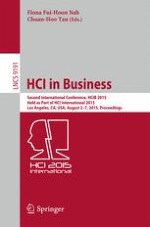2015 | OriginalPaper | Chapter
The Role of Brand Loyalty and Social Media in E-Commerce Interfaces: Survey Results and Implications for User Interfaces
Authors : Dimitrios Rigas, Hammad Akhtar Hussain
Published in: HCI in Business
Publisher: Springer International Publishing
Activate our intelligent search to find suitable subject content or patents.
Select sections of text to find matching patents with Artificial Intelligence. powered by
Select sections of text to find additional relevant content using AI-assisted search. powered by
